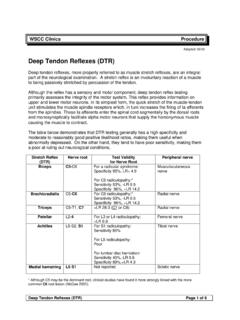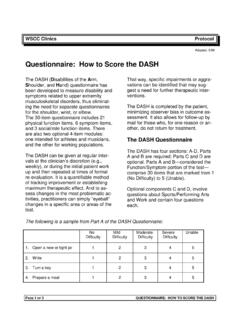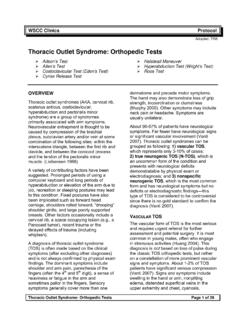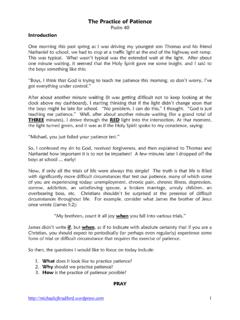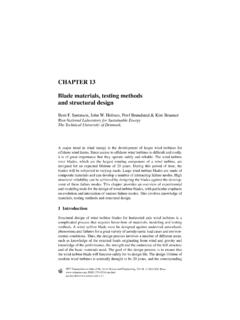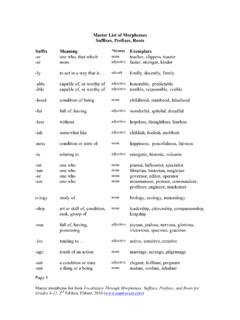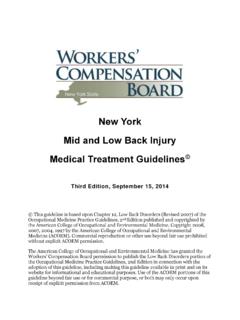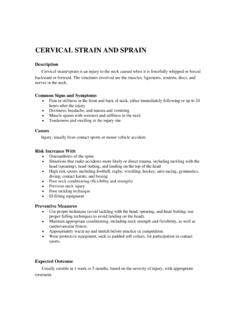Transcription of Wing FTP Server - Web Client
1 Cervical Orthopedic Tests Page 0 of 30 CERVICAL ORTHOPEDIC TESTS Cervical Orthopedic Tests Page 1 of 30 Adopted 5/05 Revised 1/21 Contents Cervical Orthopedic Tests .. 5 Test Clusters for Diagnosis of Radicular Syndromes .. 5 ARM SQUEEZE TEST .. 6 Indications for Testing .. 6 Procedure .. 6 Mechanism .. 6 Interpretation .. 6 Charting .. 6 Reliability and Validity .. 6 BAKODY S SIGN .. 7 Mechanism .. 7 Procedure .. 7 Interpretation .. 7 Charting .. 7 Reliability and Validity .. 7 BRACHIAL PLEXUS COMPRESSION .. 8 Indications for Testing .. 8 Procedure .. 8 Mechanism .. 8 Interpretation .. 8 Charting .. 8 Reliability and Validity .. 8 BRACHIAL PLEXUS TENSION 9 Indications for Testing .. 9 Procedure .. 9 Mechanism .. 9 Procedural Errors .. 9 Interpretation .. 9 Charting .. 9 Reliability and Validity.
2 9 CERVICAL COMPRESSION, JACKSON S COMPRESSION, MAXIMUM FORAMINAL COMPRESSION .. 10 Indications for Testing .. 10 Procedure .. 10 Mechanism .. 10 Cervical Orthopedic Tests Page 2 of 30 Procedural Errors .. 10 Interpretation .. 11 Charting .. 11 Reliability and Validity .. 11 Follow-up Testing .. 11 CERVICAL DISTRACTION .. 11 Indications for Testing .. 11 Procedure .. 11 Mechanism .. 12 Procedural Errors .. 12 Interpretation .. 12 Charting .. 12 Reliability and Validity .. 12 Follow-up Testing .. 13 CERVICAL FLEXION (includes Brudzinski s sign, Lhermitte s sign, Lindner s sign) .. 13 Indications for Testing .. 13 Procedure .. 13 Mechanism .. 13 Procedural Errors .. 13 Interpretation .. 14 Charting .. 14 Reliability and Validity .. 14 Follow-up Testing .. 14 CERVICAL FLEXION ROTATION TEST .. 15 Indications for Testing .. 15 Procedure .. 15 Mechanism .. 15 Procedural Errors.
3 15 Interpretation .. 15 Charting .. 15 Reliability and Validity .. 15 CERVICAL RESISTED MUSCLE TESTS (includes O Donoghue maneuver) .. 16 Indications for Testing .. 16 Procedure .. 16 Mechanism .. 16 O Donoghue maneuver .. 16 Procedural Errors .. 16 Interpretation .. 17 Charting .. 17 Cervical Orthopedic Tests Page 3 of 30 Reliability and Validity .. 17 DEEP NECK FLEXOR ENDURANCE TEST and JULL S 18 Indications for Testing .. 18 Procedure .. 18 Interpretation .. 18 Reliability and Validity .. 18 RUST S 19 Indications for Testing .. 19 Procedure .. 19 Mechanism .. 19 Interpretation .. 19 Charting .. 19 Reliability and Validity .. 19 Follow-up Testing .. 19 SHOULDER ABDUCTION TEST .. 20 Indications for Testing .. 20 Procedure .. 20 Mechanism .. 20 Procedural Errors .. 20 Interpretation .. 20 Charting .. 20 Reliability and Validity .. 20 Follow-up Testing .. 20 SHOULDER DEPRESSION.
4 21 Indications for Testing .. 21 Procedure .. 21 Mechanism .. 21 Procedural Errors .. 21 Interpretation .. 21 Charting .. 22 Reliability and Validity Unknown.. 22 Follow-up Testing .. 22 SOTO-HALL TEST .. 23 Indications for Testing .. 23 Procedure .. 23 Mechanism .. 23 Procedural Errors .. 23 Interpretation .. 23 Charting .. 23 Cervical Orthopedic Tests Page 4 of 30 Reliability and Validity .. 23 Follow-up Testing .. 23 TINEL S SIGN .. 24 Indications .. 24 Procedure .. 24 Tinel s sign suggesting nerve root .. 24 Tinel s sign suggesting cervical or brachial plexus .. 24 Reliability and Validity .. 24 Authors .. 24 REFERENCES .. 25 APPENDIX A: SUMMARY OF EXAM PROCEDURES TO PERFORM FOR SUSPECTED CERVICAL RADICULOPATHY .. 27 APPENDIX B: SUMMARY OF EXAM PROCEDURES TO PERFORM FOR SUSPECTED CORD LESIONS .. 28 Neurological exam procedures indicating loss of function of the posterior 28 Neurological exam procedures indicating UMNL (upper motor neuron lesion).
5 28 Optional neurological procedures for suspected cervical cord compression .. 28 APPENDIX C: SUMMARY OF EXAM PROCEDURES TO PERFORM FOR SUSPECTED BRACHIAL PLEXUS, NEUROVASCULAR, OR OTHER NERVE ENTRAPMENT SYNDROMES .. 29 Orthopedic and palpatory procedures indicating tension/irritation in the spinal nerves, brachial plexus, or peripheral nerves .. 29 Orthopedic/palpation procedures indicating compression of the brachial plexus, TOS or other neurovascular conditions .. 29 Neurological exam procedures to screen for loss of function .. 29 APPENDIX D: CHARTING THE RESULTS OF PAIN PROVOCATION TESTS .. 30 Recording positive results .. 30 Basic principles .. 30 Optional .. 30 Recording negative results .. 30 Record inability to perform a test .. 30 Cervical Orthopedic Tests Page 5 of 30 Cervical Orthopedic Tests This protocol contains descriptions of various orthopedic tests applied to the cervical region.
6 The following tests are included: Arm Squeeze Test Bakody s Sign Brachial Plexus Compression Brachial Plexus Tension Test Cervical Flexion (including Brudzinski s Sign, Lhermitte s sign, Lindner s sign) Cervical Flexion Rotation Test Cervical Compression, Jackson s Compression, Maximum Foraminal Compression(Spurling s) Cervical Distraction Cervical Resisted Muscle Tests and Passive Range of Motion (O Donoghue maneuver) Rust s Sign Shoulder Abduction Test Shoulder Depression Soto-Hall Test Tinel Sign In addition, there are four appendices offering an overview of tests that can be performed as packages based on the suspected type of condition and an appendix with advice for charting. Appendix A: Summary of exam procedures to perform for suspected cervical radiculopathy Appendix B: Summary of exam procedures to perform for suspected cord lesions Appendix C: Summary of exam procedures to perform for suspected brachial plexus, neurovascular, or other nerve entrapment syndromes Appendix D: Summary of exam procedures to perform for suspected lumbosacral radiculopathy Appendix E: Charting the results of pain provocation tests Test Clusters for Diagnosis of Radicular Syndromes One study of mild to moderate C6-C7 radicular syndromes (based on EMG and nerve conduction studies) has suggested that the following cluster of findings may be of diagnostic value: 1.
7 Symptom reproduction with cervical compression with the neck in lateral flexion to the side of pain 2. symptom reduction with cervical distraction 3. symptom reproduction with an upper limb tension test 4. cervical rotation reduced to less than 60 degrees toward the side of pain. If 3 out of 4 of the above tests were positive, the likelihood of cervical radiculopathy increased from 23% to 65% (LR+ ); when all four were positive, the probability rose to 90% (LR+ ). (Wainner 2003) A more recent systematic review suggested that a combination of a positive Spurling s test, axial traction (cervical distraction) test, and Arm Squeeze test may be used to increase the likelihood Cervical Orthopedic Tests Page 6 of 30 of a cervical radiculopathy, whereas a negative outcome of combined Upper Limb Neural Tension tests (ULNTs) and Arm Squeeze test may be used to decrease the likelihood.
8 (Thoomes 2018) ARM SQUEEZE TEST Indications for Testing This test maybe useful in differentiating whether pain in the shoulder region is due to a nerve root lesion or a lesion of the shoulder girdle. Procedure With the patient seated and the examiner standing behind the patient, the examiner places their hand on the middle third of the patient s arm (fingers over biceps and thumb over triceps) and applies a firm squeeze with approximately 6 to 8 kg of force. For comparison, digital pressure of the same amount of force is also carried out on the acromioclavicular and anterolateral-subacromial area. The patient is asked to rate their pain with each of the squeezes. Mechanism The anatomic rationale of the test is that in the middle third of the arm, the musculocutaneous nerve (C5 to C7), the radial nerve (C5 to T1), the ulnar nerve (C7 to T1) and the median nerve (C5 to T1) are relatively superficial and therefore squeezing the arm with moderate compression will create tension in these nerves and cause pain if any of the included nerve roots are irritated.
9 Pressure in the region would not typically be painful with lesions of the shoulder. Interpretation Squeezing the middle third of the upper arm is more likely to elicit a reaction of local pain in patients with cervical nerve root irritation from C5 to T1, not when the pain arises from the shoulder. If this squeeze is more painful than the comparative squeezes, it is more likely that the patient s shoulder pain is due to a nerve root lesion. The test is considered positive when the patient rates the pain at least 3 points higher with the arm squeeze than with the squeezes at the acromioclavicular and anterolateral-subacromial areas. Charting The location of the squeezes should be noted as well as the patient s reported pain intensity with each. Reliability and Validity A study by Gumina (2013) found a specificity of 96% with a +LR of 24 and a sensitivity of 95% with a -LR of Interexaminer reliability was reported as k= .81 and intraexaminer reliability as k =.
10 87. Cervical Orthopedic Tests Page 7 of 30 BAKODY S SIGN Indications for Testing Mechanism This is not a test but is simply observed in the patient with neck and/or arm symptoms. Procedure Patients may present in this posture, which should be immediately recognized as a red flag. The hand may or may not be resting on the head since axial compression can provoke even more discomfort. Nervous tissue. Raising the arm overhead tends to reduce neurological tension in the nerve roots, spinal nerves, and the brachial plexus, and may also decrease intraforaminal pressure. Interpretation The sign, when it reduces peripheral symptoms in the upper extremity, is suggestive of cervical radiculopathy. The presence of this sign also suggests that abduction of the arm may be helpful during cervical joint palpation and manipulation. (See UWS care pathway, Neck Pain and Arm Symptom.)
